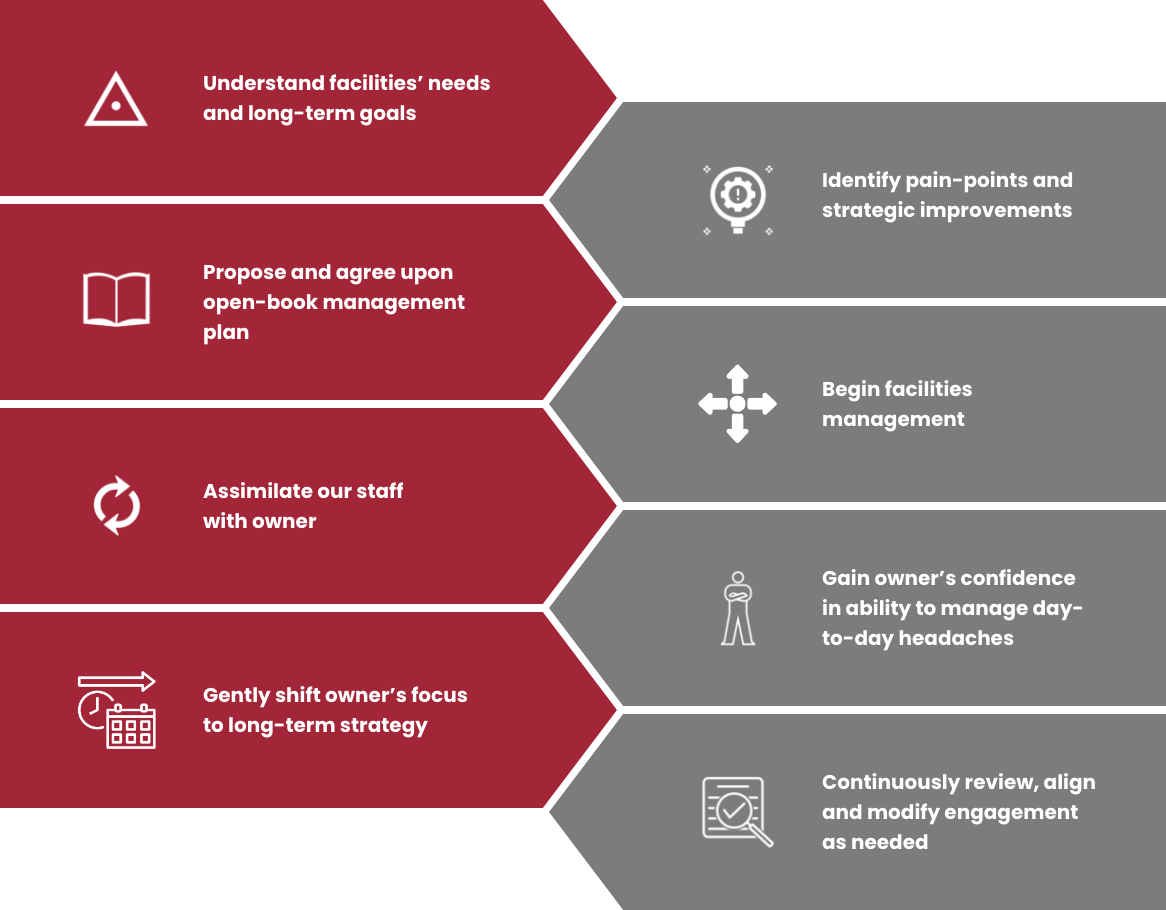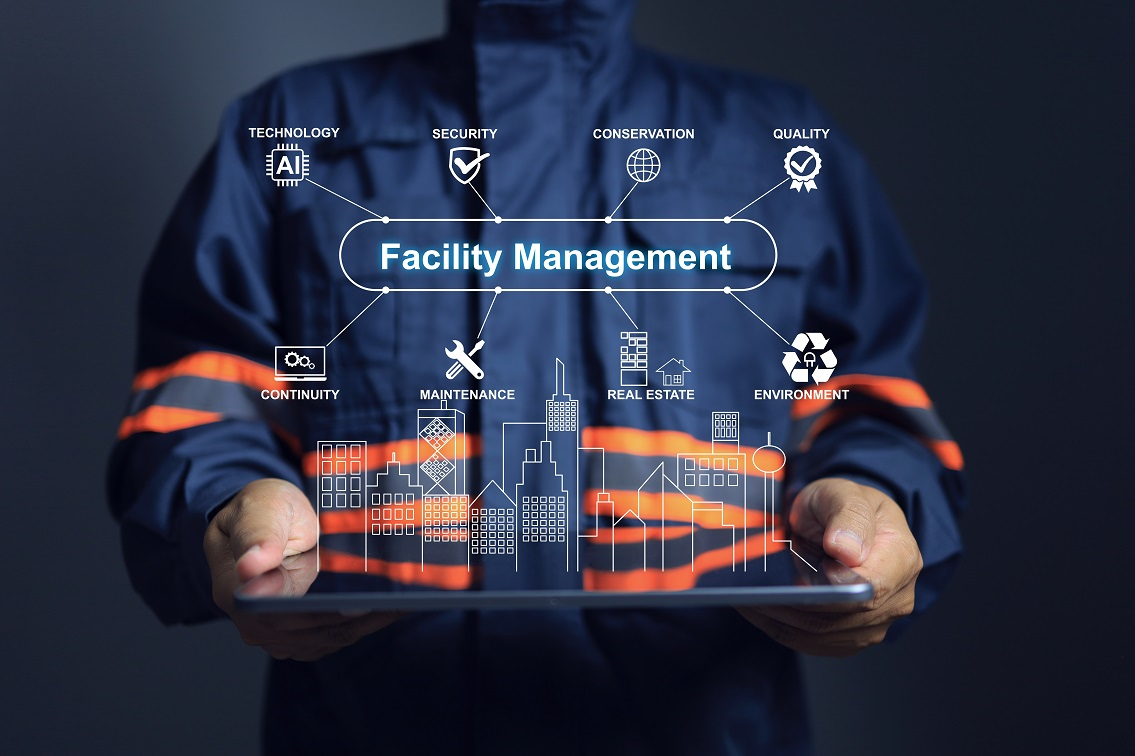The Role of Facility Management in Sustainable Workflow
The Role of Facility Management in Sustainable Workflow
Blog Article
The Vital Guide to Facility Monitoring: Methods for Success
Center administration plays an important function in the overall success of an organization, working as the foundation that supports safety and security, performance, and effectiveness. By using calculated methods such as integrated technical options and promoting cross-departmental collaboration, companies can considerably enhance their functional foundations. Nonetheless, the nuances of reliable facility management prolong beyond plain logistics and require a thorough understanding of both measurable and qualitative metrics. As we check out these essential methods, a closer examination exposes how they can transform not simply facilities, however the actual culture within an organization itself. What might these makeovers appear like in technique?
Comprehending Center Administration
What comprises reliable center monitoring? Reliable center monitoring incorporates the control of numerous business features to make certain that constructed settings are secure, reliable, and helpful to performance. It integrates the concepts of architecture, business, and engineering administration to create a seamless functional circulation within an organization.
Crucial element of center monitoring consist of space planning, upkeep monitoring, and conformity with health and safety guidelines. Area preparation concentrates on maximizing making use of physical resources to support organizational goals, while maintenance administration makes certain that centers are maintained in optimal condition, making best use of lifespan and reducing operational costs. Compliance with legal and regulatory requirements is crucial, as it safeguards the organization against potential liabilities and boosts its reputation.
Furthermore, effective center monitoring relies upon the tactical usage of technology, such as Building Management Systems (BMS) and Computer-Aided Center Monitoring (CAFM) devices. These innovations help with real-time monitoring of structure systems and streamline maintenance procedures (Facility Management). Eventually, a detailed method to facility monitoring not just promotes operational effectiveness however also cultivates a favorable atmosphere for visitors and employees alike, driving total organizational success

Key Methods for Optimization
Optimizing facility monitoring calls for a tactical technique that aligns operational methods with organizational goals. To attain this, the first essential method is the execution of integrated technological services. Using sophisticated software application systems enables real-time monitoring of center procedures, facilitating data-driven decision-making and improving total performance.
Second of all, normal analyses of center performance are necessary. Performing regular inspections and audits enables facility managers to identify areas that need improvement, guaranteeing that resources are assigned successfully. This aggressive technique aids in decreasing downtime and boosting solution distribution.
An additional essential approach is cultivating cooperation throughout divisions. By motivating open interaction between teams, facility supervisors can much better straighten their techniques with company goals, leading to improved operational harmony. In addition, involving personnel in training programs promotes a society of liability and boosts their capability to add to optimization efforts.
Enhancing Safety And Security Methods
Enhancing security procedures is vital for producing a secure setting within centers. An extensive safety and security method not only protects staff members and site visitors however also boosts operational efficiency. Facility Management. To accomplish this, facility supervisors should conduct routine risk analyses this content to make certain and determine potential threats that suitable measures are in area

Additionally, clear communication channels must be developed to report safety and security problems promptly. This consists of developing an easily accessible system for workers to voice prospective risks or events without fear of reprisal. Furthermore, leveraging technology can boost safety and security procedures; for instance, carrying out monitoring systems and gain access to controls helps monitor facility tasks and limit unapproved entry.
Last but not least, compliance with local guidelines and industry standards is non-negotiable. Normal audits and evaluations of safety methods make sure alignment with existing legislations and ideal methods. By prioritizing these methods, facility supervisors can cultivate a culture of security that protects all stakeholders and inevitably adds to the company's success.
Improving Workplace Setting
A positive office environment dramatically improves staff member morale and performance, making it an important focus for facility monitoring. To produce such a setting, facility managers need to prioritize a number of crucial elements, including functional designs, looks, and staff member engagement.
Ergonomic factors to consider are vital to lessen physical pressure and discomfort. This includes supplying flexible furniture, appropriate illumination, and appropriate room for motion. These changes can cause lowered absenteeism and increased work fulfillment.
Appearances play a vital duty in shaping the work environment ambience. Utilizing color psychology, natural illumination, and plant can cultivate a inviting and promoting atmosphere. Attentively designed rooms can improve creative thinking and improve overall wellness.
In addition, encouraging employee engagement through inclusive decision-making processes can enhance the sense of ownership and belonging. Collecting responses on office renovations and including workers in the style process can result in a more tailored setting that fulfills their demands.
Last but not least, advertising wellness initiatives, such as wellness programs and leisure areas, can better add to an encouraging office culture. By focusing on these strategies, center supervisors can efficiently improve the office setting, driving both employee fulfillment and organizational success.
Gauging Success in Facilities
Determining success in facility management calls for a detailed method that evaluates both measurable and qualitative metrics. Quantitative metrics commonly include essential performance indications (KPIs) such as space application prices, continue reading this energy usage, maintenance prices, and occupancy degrees. These metrics offer a clear image of functional efficiency and economic performance, click this permitting facility supervisors to identify locations for improvement and standard against sector standards.
Qualitative metrics, on the various other hand, concentrate on individual satisfaction and staff member engagement. Studies and feedback systems can gauge exactly how well the centers satisfy the demands of occupants, assisting to assess the general office environment. This facet is important, as a completely satisfied workforce is commonly linked to enhanced performance and retention rates.
To efficiently gauge success, facility managers must additionally consider incorporating technology, such as developing monitoring systems and data analytics tools, to gather and assess pertinent data. On a regular basis reviewing both collections of metrics permits a much more well balanced sight of efficiency and informs tactical decisions. Eventually, an effective center monitoring strategy rests on a commitment to constant enhancement, making certain that both functional efficiencies and individual fulfillment are focused on.

Verdict
In conclusion, efficient center monitoring is important for boosting business efficiency. Prioritizing safety and security methods and boosting workplace environments even more add to enhanced worker satisfaction.
Facility management plays an important duty in the total success of an organization, serving as the backbone that supports effectiveness, efficiency, and security.Trick components of center administration include space preparation, upkeep administration, and compliance with health and safety regulations.Moreover, reliable facility administration relies on the critical use of modern technology, such as Structure Management Solution (BMS) and Computer-Aided Facility Administration (CAFM) devices. Eventually, an extensive method to center administration not only advertises functional efficiency yet likewise fosters a favorable atmosphere for workers and site visitors alike, driving total organizational success.
Ultimately, an effective facility monitoring technique pivots on a commitment to continuous renovation, guaranteeing that both operational effectiveness and customer contentment are prioritized.
Report this page